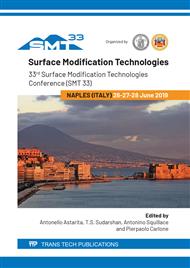p.411
p.417
p.423
p.429
p.435
p.441
p.447
p.453
p.459
Set-Up of an Experimental Procedure for the Surface Smoothing of FDM Parts through Acetone Vapor
Abstract:
Fused deposition modeling (FDM) is an additive manufacturing technology where three-dimensional physical models are manufactured by layer-by-layer deposition. However, the layered surface built with FDM suffers from poor surface quality and dimensional accuracy even for basic part geometries. This proves to be unacceptable and not satisfactory for most general purposes with the consequence of a decreased value of the final product. Several methods for post-processing were proposed to achieve fine surface of manufactured components. In particular, for components manufactured with polylactic acid (PLA) the chemical post-processing with dimethyl ketone (acetone), named vapor smoothing process, seems to be very promising to significantly improve the surface roughness. Moreover, acetone has the main advantage to have a low cost, low toxicity and high diffusion rate. However, this polishing procedure may dissolve the outer surface of the parts affecting the structural reliability of the part. In this work, a novel device, consisting of a cylindrical chamber in Pyrex, is set-up for the vapor smoothing process with acetone. The system is designed to permit the injection of a gas containing acetone at different concentrations and at different operating conditions (temperature, contact time). The samples used for the test are truncheon design manufactured using different printer settings; each truncheon is built at inclination angles varying from 0° to 45° in step of 5°. The variation of the surface roughness was investigated using a confocal microscope Leica DCM3D, equipped with the software LeicaScan and LeicaMap.
Info:
Periodical:
Pages:
447-452
Citation:
Online since:
July 2019
Keywords:
Price:
Сopyright:
© 2019 Trans Tech Publications Ltd. All Rights Reserved
Share:
Citation:



